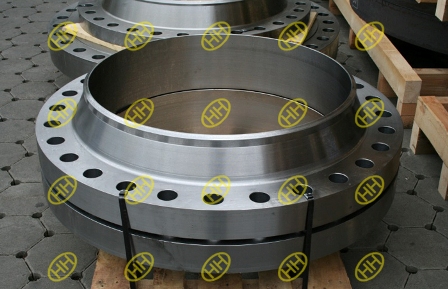What factors determine the welding thermal conductivity of flanges?
The welding of large flanges is a part that connects the pipe to the pipe. It is connected to the pipe end and sealed with a gasket. The welding of large flanges is also called welding flange. The welding flange has holes and bolts make the two flanges tightly connected. It is a disc-shaped part and is the most common in pipeline engineering.
The welding of large flanges with good thermal conductivity requires high upsetting speed (150-200mm/s). For the same metal, if the temperature gradient in the interface area is large, the upsetting speed needs to be increased due to the fast cooling rate of the joint. The upsetting pressure Fu(Fu is usually expressed by the pressure per unit area, that is, the upsetting pressure). The size of the upsetting pressure should ensure that the liquid metal in the joint can be extruded and a certain degree of plastic deformation will be produced at the joint.
Because large flanges have good comprehensive performance, they are widely used in basic projects such as chemical industry, construction, water supply, drainage, petroleum, light and heavy industry, refrigeration, sanitation, plumbing, fire fighting, electric power, aerospace, shipbuilding and so on.
When welding large flanges, if the upsetting pressure is too small, the deformation will be insufficient and the joint strength will decrease; if the upsetting pressure is too high, the deformation will be too large, the crystal lines will bend seriously, and the impact toughness of the joint will be reduced. Because the high flash speed will increase the temperature gradient, when welding metals with good thermal conductivity (copper, aluminum alloy), special steel flanges require a large upsetting pressure (150-400Mpa).
Preheating flash butt welding parameters In addition to the above process parameters, preheating temperature and preheating time should also be considered. The preheating temperature is selected according to the cross-section of the workpiece and the material properties. When welding low-carbon steel, it generally does not exceed 700-900 degrees.
Generally, manual arc welding is used for large-scale flange welding. The arc line is irregular, the edge of the lining ring is easy to burn and undercut, even if it is machined, the appearance quality is poor; 2. Since the welding of dissimilar steels is generally difficult, the welding is difficult. If the welding current is not well controlled, defects such as undercut or incomplete penetration are likely to occur. For large flanges with raised faces, the welds must be processed so that there is less deposited metal between the lining ring and the flange.


